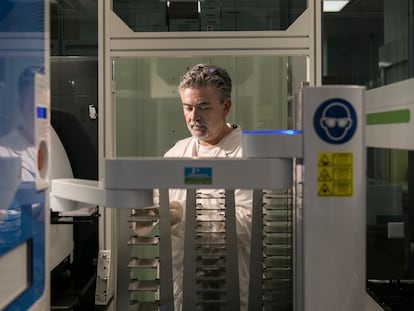The craft of healing with plants: How Andean medicine is being kept alive
During the pandemic, an association of herbalists in Quito was an important source of complementary healthcare, but the traditional treatments face continued resistance in some quarters
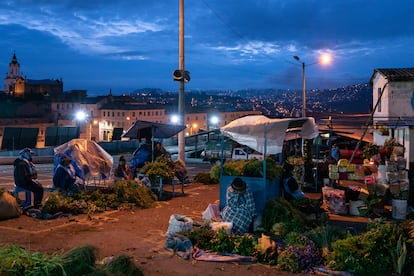
It is an early morning in October, but it could be any other day. This family has experienced such early mornings for more than four decades. Evelin Luguaña, 27, the third generation in a line of herbalists from Nayón, a small town northeast of Quito, Ecuador, gets ready for another day of picking wild medicinal plants with her mother, Norma Juiña. At 63 years old, Juiña has been an herbalist for 40 years. Nowadays, they must consider the complications wrought by climate change and real estate development. “Before, it was easier, you could just go into the ravines and pick anything,” says Juiña. “Today, everything is privatized, even the trails are being closed; it’s not fair, because medicinal plants are being lost this way.”
The truck that they rent for the occasion arrives at around 4am. Earlier, they prepared the tonga, that is, the food that will give them energy during their hikes through the hills, forests and ravines on the outskirts of the city. In a backpack, they carry potatoes, beans, roasted corn, máchica (barley flour with brown sugar) and sometimes baked chicken. In their pockets, they have some garlic cloves and branches of common rue. These last items “are taken out of respect for the hills, to avoid the bad air. Sometimes the fog can roll in and divert us from the road. They are like an amulet,” says Evelin Luguaña, who is clearly enthusiastic about her business.
Evelin and Norma will travel one or two hours, sometimes more, to reach the entrance of the Amazon. There, the ecosystem becomes humid, and in the ravines they can pick horsetail, a plant used to treat kidney and bladder infections. In their most frequent excursions through the Sierra, sickle in hand, they will pick chilca, eucalyptus, ñachag and “angel grass” (a plant in the daisy family). “Everything is picked up along the way,” Evelin explains. “You have to leave the car far away and walk inland. Then you have to quickly make little bundles with the herbs and leave, because there are people who might think that we are going out there to steal cattle.” They’ll spend the morning this way and then return home at around 3pm. They’ll unload the plants, clean them and cut them down to 65 centimeters, so that they’re uniform in size and look good. Then, they will stand the plants upright in tubs of water or put them on the floor on a mat; if they were left lying in a heap, the plants would drown to death. It will be 10pm by the time they finish. If there is a fair the next day, they will be on their feet again at midnight to pack their “suitcases,” as they call the big bundles full of plants that are tied with pieces of sack.
Today, a Friday, is a fair day. It is 4am, but the herbalists have already been working since 1am. The Primero de Mayo platform, as the city’s largest medicinal plant market is known, looks hectic. Across the street – a large avenue that connects the city’s hubs – stands the San Roque market, which symbolizes this area of Quito’s Historic Center. This neighborhood is famous for its merchants, artisans and criminals.
The platform is redolent of the sweet scent of lemon verbena and lavender, and a loudspeaker discreetly plays rock music. There are about 30 stalls selling potatoes and vegetables, along with a few popular food kiosks. But the most activity occurs at the 50 medicinal plant stalls. Herb vendors come from ancestral communities and Quito’s rural parishes. They offer the fruits of their picking labors, plants harvested from their own gardens, and what they’ve purchased or bartered from other producers to add more variety. These are the wholesale hours. Intermediaries arrive to buy items at cheap prices that they will later resell in their own stalls at other Quito markets. Here, for example, a bunch of sweet herbs costs 75 cents. They will charge double that price at another market later.
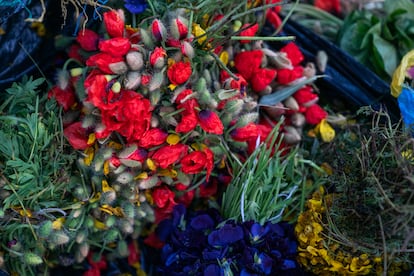
The fast-paced commerce will continue until 6am, when many vendors will take a break for breakfast. Retail customers, including those who seek healing tips from the herbalists, will arrive until noon. For poor digestion, one needs oregano, fragrant mallow and dill. For urinary tract problems, take mashua, casamarucha and plantains. To aid blood circulation, have some nettle. Norma Juiña knows how to recommend just the right thing; she trusts her gift: “God gives each person a different type of wisdom. He has given us the knowledge of medicinal herbs. Knowing how to use them, knowing how to mix them to treat a disease; that is the gift.”
The market is built on conquered land. “Before, it was all dirt and mud.... The first leaders organized us in mingas [collective work groups] to clean up everything. Everything has been done through our own efforts.” Rosa Mila, 67, is one of the area’s oldest herbalists, and she remembers the beginnings of the fair. Her story is that of a generation of women who wanted to bring the knowledge that their elders had privately passed down to them into the public sphere.
For years, they settled on the sidewalks around the San Roque Market, spending a couple of hours here, a few hours there, tying and untying the bundles they carried on their backs, until the municipal police came by to evict them. They could not go on like that, so some of those vendors, men and women alike, went to speak with the director of the Central Technical School. At that time, the school was located in that part of the city, and it had abandoned land in the back. They asked the director to let them occupy that land so they could lay the foundations of a market. On January 15, 1975, they formed the Central Primero de Mayo Association of Small Merchants (Asociación de Pequeños Comerciantes Central Primero de Mayo). From there, they took charge of turning the place into a market – some of the work they managed by themselves, while for other tasks, they received help from the local authorities. The herbalists’ fight to have a dignified space has been going on for almost five decades. Just a year ago, Quito’s municipal government installed the roofed structures that cover some of the stalls. Until then, the merchants had needed to set up tents on their own.

The market has also become a space for collective expression and organization. Over the years, the herbalists have been involved in neighborhood mingas, security brigades and community development workshops. During the market’s first two decades, they actively mobilized with labor and political groups, such as the United Workers’ Front and the Popular Democratic Movement, to achieve social demands. Moreover, they have created a dynamic of economic solidarity among women; by defending Andean health wisdom, they have been able to sustain their collective heritage. As was the case with peasant agricultural production, the Covid-19 health crisis jolted people into thinking differently; it piqued many people’s interest in the benefits of plants and prompted greater recognition of the herbalists’ work. “The disease brought people back to their roots, to our natural medicine,” says Evelin Luguaña. For Covid-19, she recommended a potent concoction of two matico leaves, a chuquiragua flower, a bit of verbena, three leaves of aromatic eucalyptus, borage flowers, some linden, a pinch of lemon verbena, a piece of ginger, grated turmeric, the juice of three lemons and honey.
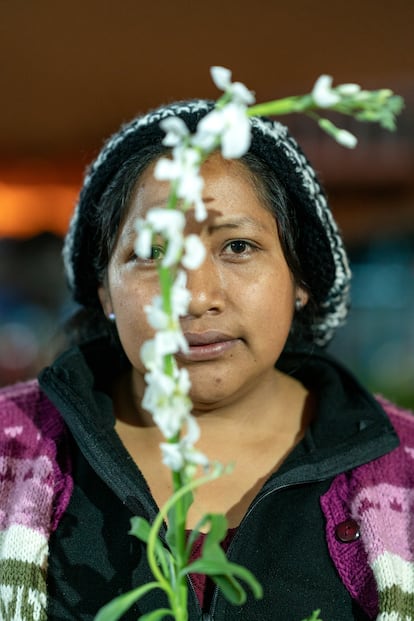
At the end of 2021, the association of herbalists received the Eugenio Espejo Award, a prize that the municipality of Quito gives to individuals or organizations that have contributed significantly to the city’s healthcare. Until then, the honor had only been bestowed on doctors and scientists. However, the Covid restrictions, including market closures, are still be felt by the herbalists today. Of the association’s 300 active members, only about half of them regularly attend the market now. The loss of clients from months of quarantine forced many herbalists to decide not to go out anymore, although some continue to grow plants to supply their colleagues. What’s more, their craft is facing many threats: real estate development, which includes even protected ecological regions in the outskirts of Quito; climate change and environmental pollution; uncertainty about the trade’s transmission to the next generation; and the expansion of supermarket chains, which monopolize customers to the detriment of popular markets.
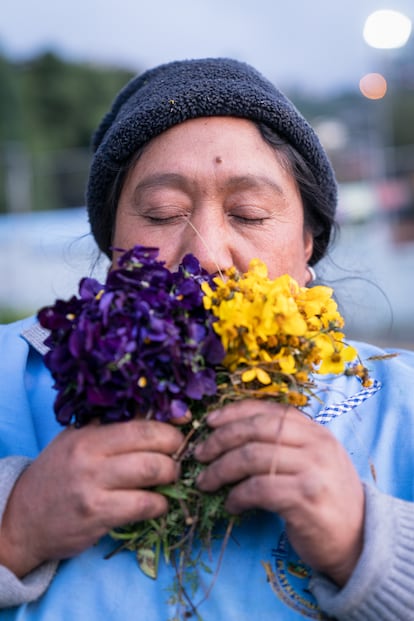
In August, the Museo de la Ciudad (City Museum), in collaboration with the Primero de Mayo Platform, mounted the exhibition Territories that Heal: An Encounter with Women Herbalists. The exhibit is an extension of an initiative that cultural institutions began in 2013, when city authorities proposed removing the San Roque market from the city’s Historic Center. The proposal generated an important debate about the processes of control and popular trade organizations. “The exhibit is a continuation of these processes,” explains Alejandro Cevallos, the coordinator of the Museo de la Ciudad, “but with the added element of having just come out of the pandemic. We wondered about the importance of recognizing the jobs that take care of people. The herbalists were sustaining […] popular access to healthcare.”
Through solid documentation that provides important educational materials, the exhibit highlights the importance of Quito’s herbalists as guardians of health, ecosystems and Andean knowledge. Among the collaborations between artists and researchers who work on the subject, the efforts of the Campaign for the Memory of Women Persecuted for Witchcraft stand out. The organization is an Ecuadorian collective linked to an international network that documents and analyzes the experiences of women accused of witchcraft throughout history, as well as how that persecution has had repercussions up to this day.
A municipal ordinance to control popular commerce, which is currently in effect, punishes engaging in so-called witchcraft in market stalls. With this official stigma attached to the herbalists, one wonders how the rest of the society views their work. “On the one hand, there is a popular sector that found the plants to be a good preventive health strategy,” explains Cevallos. “That’s not documented or legitimized, but there are repeated testimonies that plants have helped to counteract the Covid-19 crisis. However, Andean-based natural medicine also faces a very Eurocentric, whitewashed prejudice. The middle classes tend to believe that natural medicine is useful up to a certain point and that the rest is superstition. For example, in recent years, there’s been an increase in schemes to persecute and criminalize the saleswomen who walk around the Historic Center to finish selling bundles of plants. This shows how contradictory their situation is. On the one hand, they enjoy prestige, but on the other, they are persecuted in the streets.”
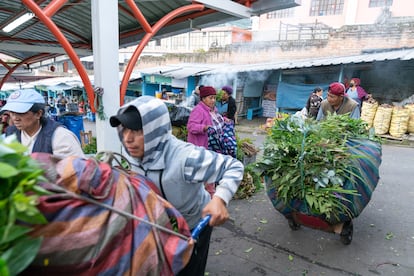
Other vendors have had better luck. When not everything is sold at the end of the day, some take the plants back home. They cut the plants into small pieces, set them to dry, ideally inside a greenhouse, and then sell them in dried bouquets or in nice potpourri bags. Evelin Luguaña offers sachets of herbs to use for anti-stress baths; the mixture has 20 ingredients, including chamomile, sweet basil, lavender, lemon verbena and roses. As she completes her sale, she will wish her customers “an excellent and blessed day.”
Tu suscripción se está usando en otro dispositivo
¿Quieres añadir otro usuario a tu suscripción?
Si continúas leyendo en este dispositivo, no se podrá leer en el otro.
FlechaTu suscripción se está usando en otro dispositivo y solo puedes acceder a EL PAÍS desde un dispositivo a la vez.
Si quieres compartir tu cuenta, cambia tu suscripción a la modalidad Premium, así podrás añadir otro usuario. Cada uno accederá con su propia cuenta de email, lo que os permitirá personalizar vuestra experiencia en EL PAÍS.
¿Tienes una suscripción de empresa? Accede aquí para contratar más cuentas.
En el caso de no saber quién está usando tu cuenta, te recomendamos cambiar tu contraseña aquí.
Si decides continuar compartiendo tu cuenta, este mensaje se mostrará en tu dispositivo y en el de la otra persona que está usando tu cuenta de forma indefinida, afectando a tu experiencia de lectura. Puedes consultar aquí los términos y condiciones de la suscripción digital.
More information
Últimas noticias
Welcome to the post-religion era: The idea of Christianity as the absolute truth has become obsolete
‘I thought you would like it’: The risky sexual practice popularized by TV shows and TikTok
The digitalization of tourism: ‘They promise experiences and gave us the worst possible one’
Mexican peso defies uncertainty with forecasts of a new period of stability in 2026
Most viewed
- Sinaloa Cartel war is taking its toll on Los Chapitos
- Reinhard Genzel, Nobel laureate in physics: ‘One-minute videos will never give you the truth’
- Oona Chaplin: ‘I told James Cameron that I was living in a treehouse and starting a permaculture project with a friend’
- Why the price of coffee has skyrocketed: from Brazilian plantations to specialty coffee houses
- Silver prices are going crazy: This is what’s fueling the rally

